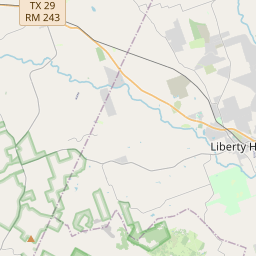Zion Lutheran Church
Historical marker location:






Zion Lutheran Church of Concordia was established in 1882 as a place of worship for immigrants of German-Wendish descent. The Wends are a Slavic people from the German area of Lusatia, near the border with the Czech Republic and Poland. Settlers immigrated to Texas in the 1850s with the Reverend John Kilian. After founding a new homeland in present-day Serbin (Lee County), a number of the pioneers began migrating in the late 1870s to the northeastern part of Williamson County. Their settlement later became known as Walburg.
Under the guidance of the Reverend J.H. Maisch, settlers organized the Zion Evangelica Lutheran Church of Concordia here. The church’s nine charter members were Wilhelm Andres, August Doehre, Albert Krause, John Neitsch, Albert Ramm, Andreas Schneider, Jacob Schomber, John Schulze and Carl Streich.
The church cemetery was also established in 1882, with the first recorded burial occurring the same year. Since education was of primary importance to the settlers, they also founded a school at that time which continues to educate students today.
The congregation grew throughout the years despite challenges. A fierce June 1886 tornado wreaked havoc on the community and moved the church building off its foundation. Members have rebuilt and placed additions on both the school and the church. After over a century, Zion Lutheran Church and School continue to impact the residents of Walburg and Williamson County by serving as a place of worship and an educational institute. Since 1971, the church has served the community through the annual Wurstbraten sausage supper.
(2006)
As one of the most visible programs of the Texas Historical Commission (THC), historical markers commemorate diverse topics in Texas history, including: the history and architecture of houses, commercial and public buildings, religious congregations, and military sites; events that changed the course of local and state history; and individuals who have made lasting contributions to the state, community organizations, and businesses.
Texas has been a major oil-producing state for over a century. The first big oil discovery in Texas was the Spindletop field near Beaumont in 1901, which set off a massive oil boom that transformed the state's economy and made Texas one of the wealthiest states in the country.
The region was first settled by European pioneers in the mid-19th century. The establishment of Fort Tumlinson in 1839 provided protection to settlers, and the population grew steadily with the arrival of more immigrants in search of new opportunities. In 1848, the county was officially organized and named after Robert McAlpin Williamson, a judge and soldier in the Republic of Texas.
During the Civil War, Williamson County faced significant challenges. Many residents joined the Confederate Army, and the county became a hotbed of conflict due to its location on the frontier between Union and Confederate territories. After the war, the area was able to rebuild and experienced a period of economic growth, driven by agriculture, cattle ranching, and the emergence of small towns and rural communities.
In the 20th century, Williamson County continued to develop and adapt to changing times. The discovery of oil in the early 1900s brought economic prosperity to the region, and the county experienced a boom in population and infrastructure. Today, Williamson County is a thriving part of the greater Austin metropolitan area, known for its strong economy, vibrant communities, and commitment to preserving its historical roots.
Williamson County Timeline
This timeline provides a condensed summary of the historical journey of Williamson County, Texas.
- 1804 - The area that is now Williamson County is settled by Native American tribes, including the Tonkawa, Lipan Apache, and Comanche.
- 1836 - Texas gains independence from Mexico.
- 1838 - The Texas legislature establishes Williamson County, named after Robert McAlpin Williamson, a leader in the fight for Texas independence.
- 1848 - The Mexican-American War ends and the Treaty of Guadalupe Hidalgo is signed, officially establishing the Rio Grande as the boundary between Texas and Mexico.
- 1850 - The population of the county reaches 1,027.
- 1876 - The Texas State Capitol building is completed in Austin, which becomes the seat of government for Williamson County.
- 1881 - The International-Great Northern Railroad reaches Georgetown, bringing economic growth and development to the county.
- 1907 - The county courthouse, located in Georgetown, is completed.
- 1930s - The Great Depression hits Williamson County, causing a decline in the local economy.
- 1950s - The county experiences a period of growth and prosperity, with the population increasing significantly.
- 1990s - Development and suburbanization accelerate in Williamson County, with the county becoming one of the fastest-growing areas in the United States.